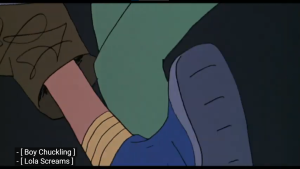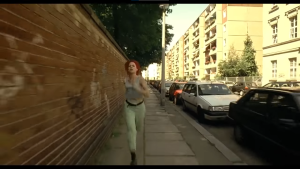Author: Evan Leyden
Evan Leyden – Video Essay | Morning Run
Evan Leyden – Final Project
Evan Leyden | Final Project Rough Draft
HTML Media Project
https://dtc-wsuv.org/eleyden22/Media%20Project/
AI Film
Week 5 Blog Post
Blog: Search for 3 short looped videos or gif animations that express a quality of time: cyclic, slow, timeless, frantic, rhythmic. With each loop that you post, discuss briefly how editing manipulates time for the effect. (Tik Tok, Instagram and other social media you can post into WordPress using the embed code, if not the link itself)
@filip.ino Just wait till I smash it on him #loop #perfectloop
This Loop is the most narrativized of the 3 but it is simple in its execution. Composing of 2 cuts between the characters exchanging the guitar but noticeably, they are both facing the same direction. While it’s not hard to figure out what is being conveyed in the passing of the guitar it makes it feel a little off even if the loop is fine.
@tannerlippold I may have just broke the internet with this one #fyp #foryou #loop #loops #perfectloop #looping #homemade
This loop holds the same angle for the duration of the video with footage composited over to give the effect of the doppelganger. The door’s position at the end is what makes the loop seamless. The editing of a loop like this is harder as the precision needs to be in place due to no easy cut to hide the inconsistencies.
@joezvonar THE CLEANEST LOOP YOU WILL EVER SEE! #fyp #perfectloop #editing #vfx #viral
This loop is fairly similar to the last one, but with flashier editing. It is far easier to hide the cuts in this one as there isn’t any single element that is fiddled with that remains on screen. Every “person” at some point leaves the screen leaving all the errors to the editor in case shadows overlap. The spacing in the camera seems good enough however that the shadows never became an issue. While this one has “better” editing due to its effects, I feel that it was less interesting due to it being over complicated and not having that precision the above loop did.
Week 4 Blog Post
Blog Prompt: The art of cinema involves the manipulation of the viewer’s experience of time. The duration of a shot is like a temporal framing. In “Time Frames”, McCloud describes the various comics techniques for creating different temporalities. Reading McCloud, consider the framed panel in a comic as a cinema shot. Wider or longer panels are like shots with longer durations (“long takes”). Smaller panels are like shots of shorter durations. The main difference between comics and film is that with a page of arranged panels, the reader has a spatial “time map” in the simultaneous display of frames. In cinema, shots are mostly sequential and present an unfolding now. Discuss some aspect of McCloud’s visual essay that makes you think of the possibilities of time manipulation in digital cinema or of a certain movie scene that plays with time.
The very first thing that come to mind based off of this is in discontinuity. One where an individual is speaking to the outside as time passes on by hours, days, or even seasons all the while cutting back to the speaker show no time really passed for him. Does this imply him to be ageless, immortal, or was the time lapse even real or just in his head.
Displaying a pause by having a single panel that was lengthened out is such an obvious thing for comics that I can’t believe I never noticed it before. Adapting it for film could help imply longer time has passed by having a longer shot or just imply that the parties were given a moment to think.
In a medium that is more restrictive in how it can display motion, it has to get creative, and these creative ideas don’t just work for comics, but can be extrapolated to other mediums as well. I probably would have used a long shot for the reasons I described above just because maybe “it felt right for the scene” but because of the ability to understand why it works in a different medium I understand the principal in this one better. Because I know why it works, I can use the tool better.
Week 3 Blog Post
Blog Prompt: Watch the 12 min silent 1929 film by Dimitri Kirsanoff called Brumes d’automne (Autumn Mists). In this experimental short there is no plot just the visualized thoughts of a woman. Describe the editing. What is she thinking? Does the montage work? Does it evoke something for you? Kirsanoff said that his intention in the film was to represent a state of mind “through drastically changed images in which nature was losing its density and unity.”
Very early on a connection is established between a shot of the woman looking blankly followed by an empty frame of a subject being what she was looking at. This is established with the paper in the fire very early on and this set, at least for me, the expectation that any shot of her face and a shot that was harder to connect must be the focus of her vision. Her looking at the papers, then the man, then the wilderness instills in me a great feeling of longing. She wants to be free of the place she in and when she finally leaves, she gets to wander in the beauty of the outside. Her face isn’t shown in focus like it was before this point anymore, with some acceptations, but for the most part her legs and feet are the focus as traveling and being outside become the forefront. During the only prolonged focus on her gaze after this, it is more of a blurry messy trip that obviously displays stress but the exact reasoning is hard to pin down and left up to interpretation. All of the shots are of very discontinuous outside images that evoke the feeling of outdoors but don’t ground you in any particular place. The piece ends up feeling very dreamy with no meaning easily parsed as everything is left to the viewer to interpret.
Week 1 Blog Post
Blog Prompt: How does the movie retain narrative momentum despite all the time shifts? What narrative forces/desires drives the edits of shot to shot? In what ways is time “stretched” or “compressed” and how is the effect achieved? These questions are only “prompts” for your own thoughts about the narrative, cinematography and editing styles of the Run Lola Run. Take screen grabs to support your thoughts.
Run Lola Run is able to keep a strong momentum due to the impactful pacing of the movie where you get to see how Lola will go through it this time. Faster, slower, different, and better all weaving back and forth to create an interesting interplay between the familiar and the foreign events.
Every loop starts with a staircase scene but if Lola was in complete control and just learning from the loops, you’d think that she’d descend the staircase faster, but instead the boy sticks his leg out to trip her.

This set expectations for the 2nd loop early on by showing that even though Lola gets to go through things again, it wont be the same. Personally, I was hooked by the thought of these anomalies and payed extra attention to see what was different about this new “run”.

It served to even make the long shots at the beginning of each run fresh as they set the tone fantastically for the first time through, but in subsequent runs, what would there be to change in an interesting way. If Lola was truly the only character with agency than the only thing she could do is run faster, but the small changes around her like the woman with the stroller create differences small enough to keep the viewer from feeling like they’ve seen this before.
Week 7 Blog Post
Prompt: Generate a 200 – 300 word story about the unexpected death of a romantic partner
ChatGPT Response: In the quiet, picturesque town of Willow Creek, Sarah and James were the epitome of a perfect couple. Their love story was one that seemed destined for eternity, woven with shared laughter, dreams, and a bond that weathered life’s storms. But fate often writes its own narrative, unfurling unexpected twists in the gentlest of moments.
Loops
Looping Videos | Evan’s Cut | Evan & Jackson
Looping videos worked on by Evan Leyden & Jackson Lester